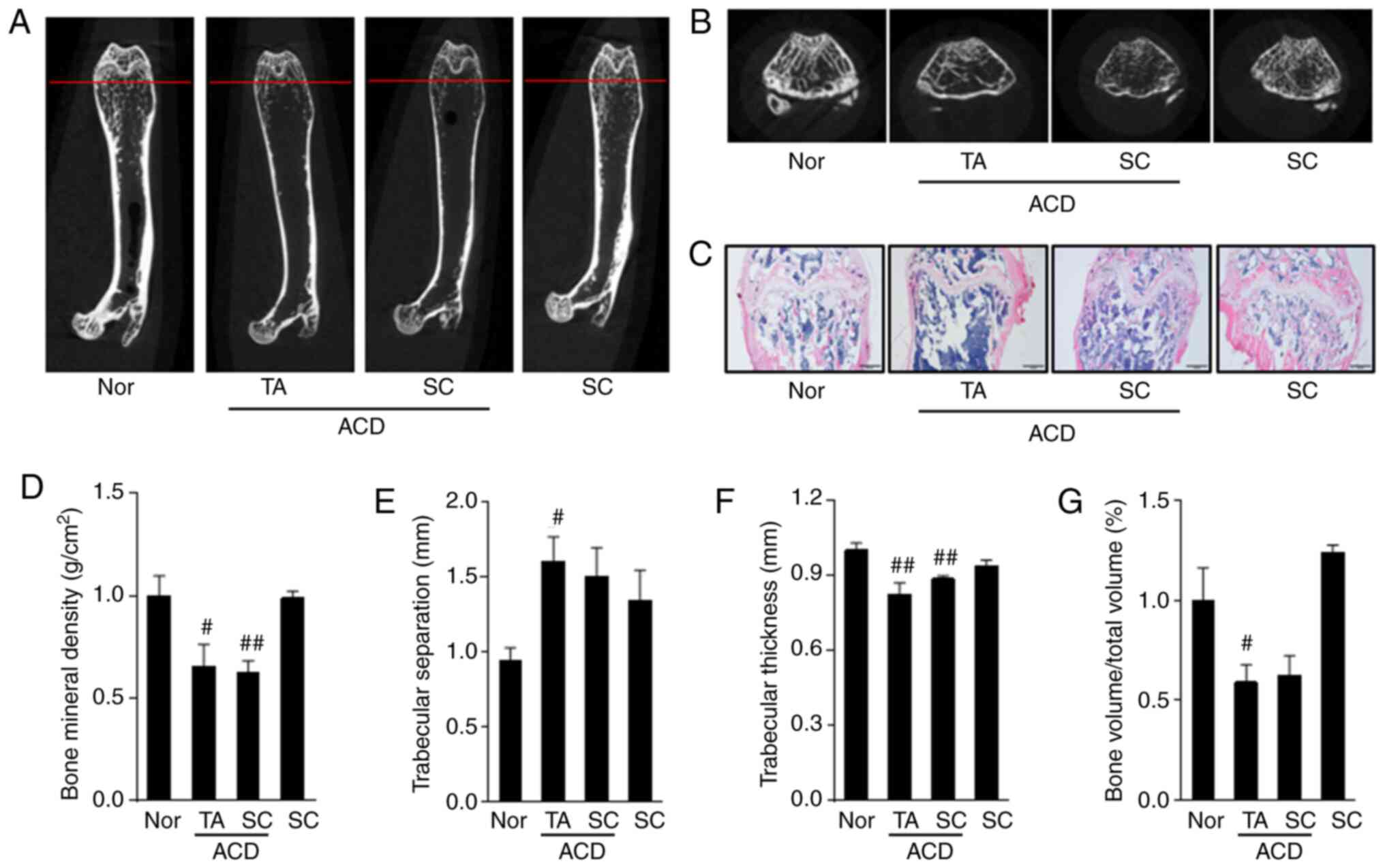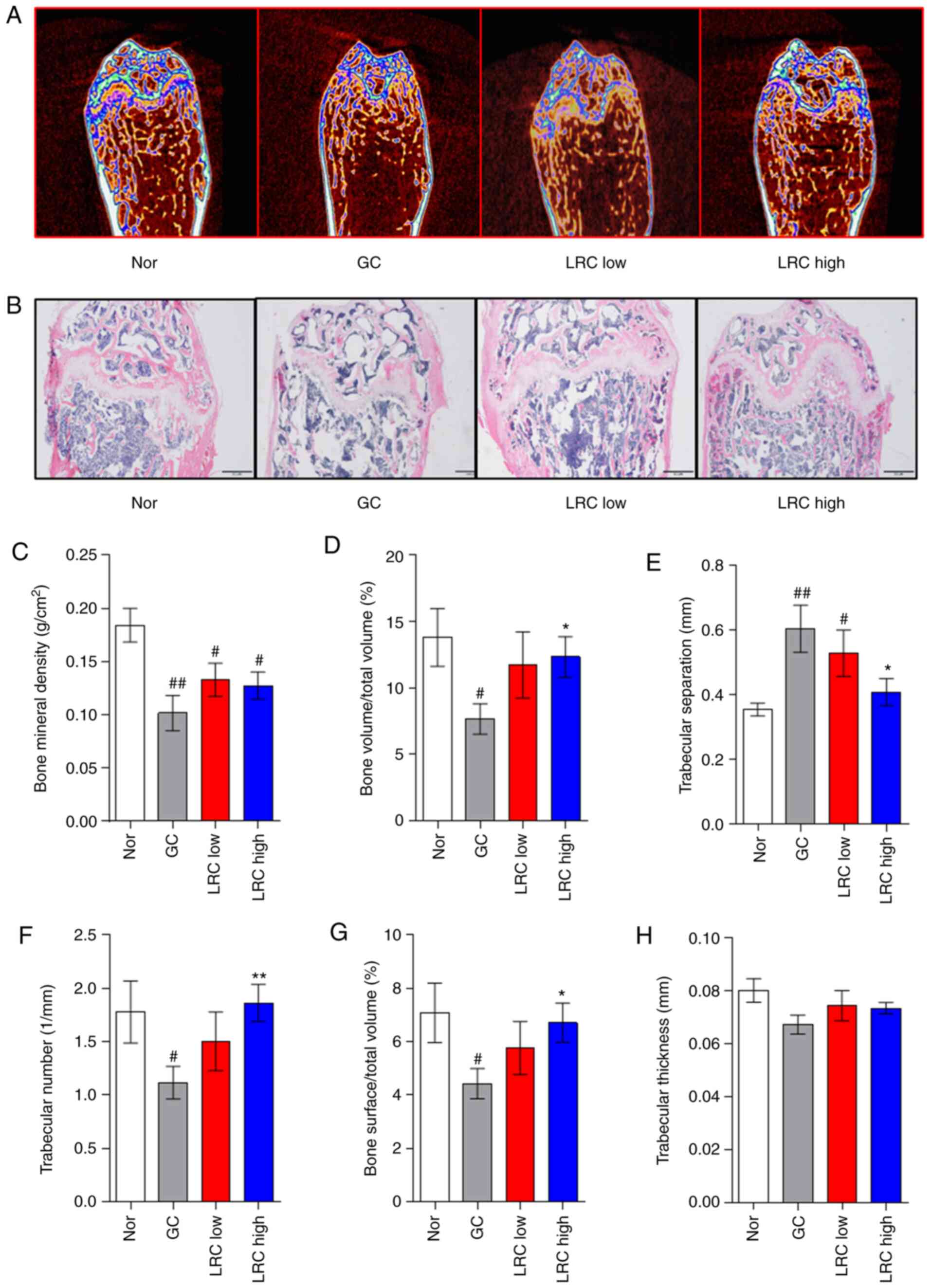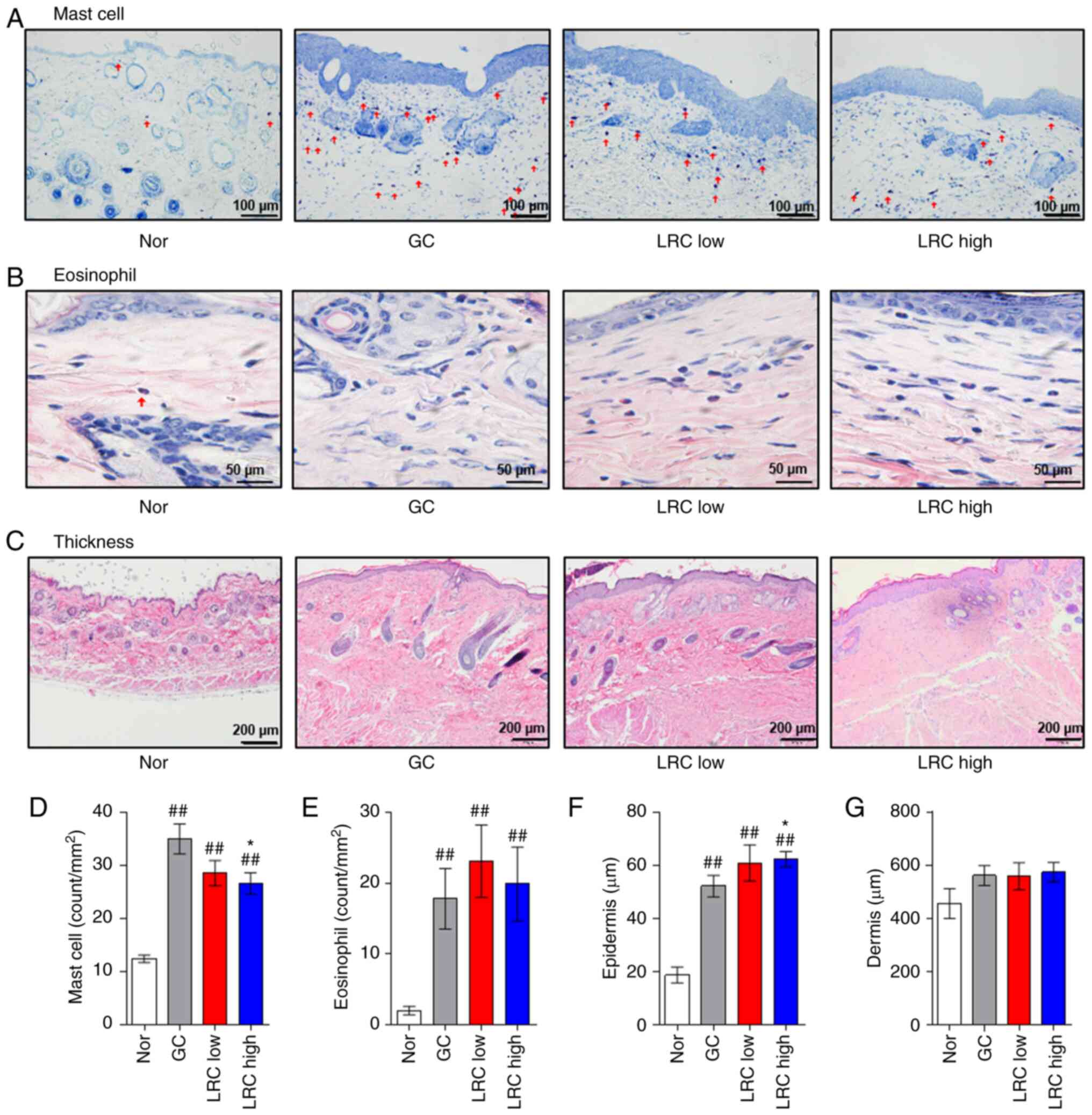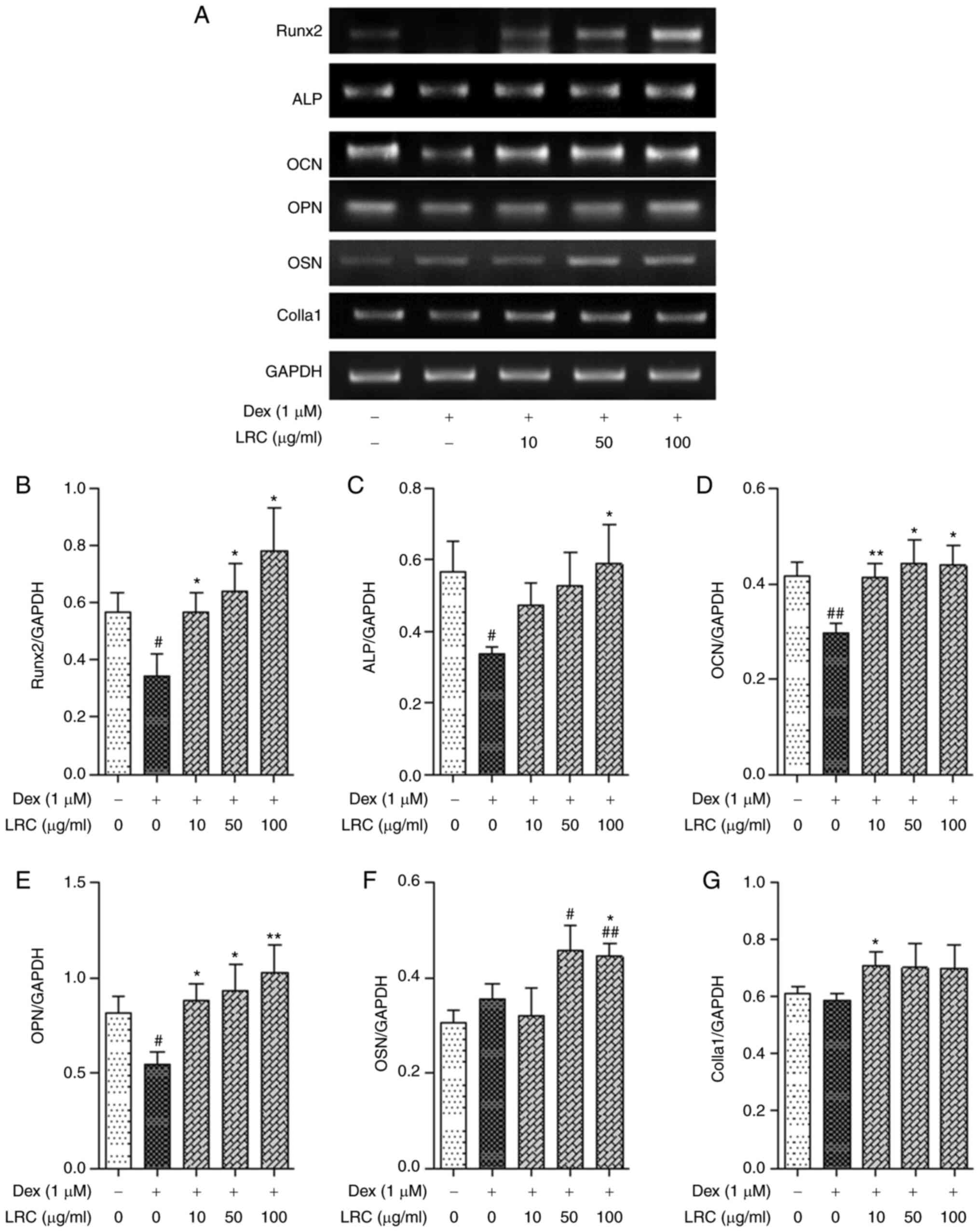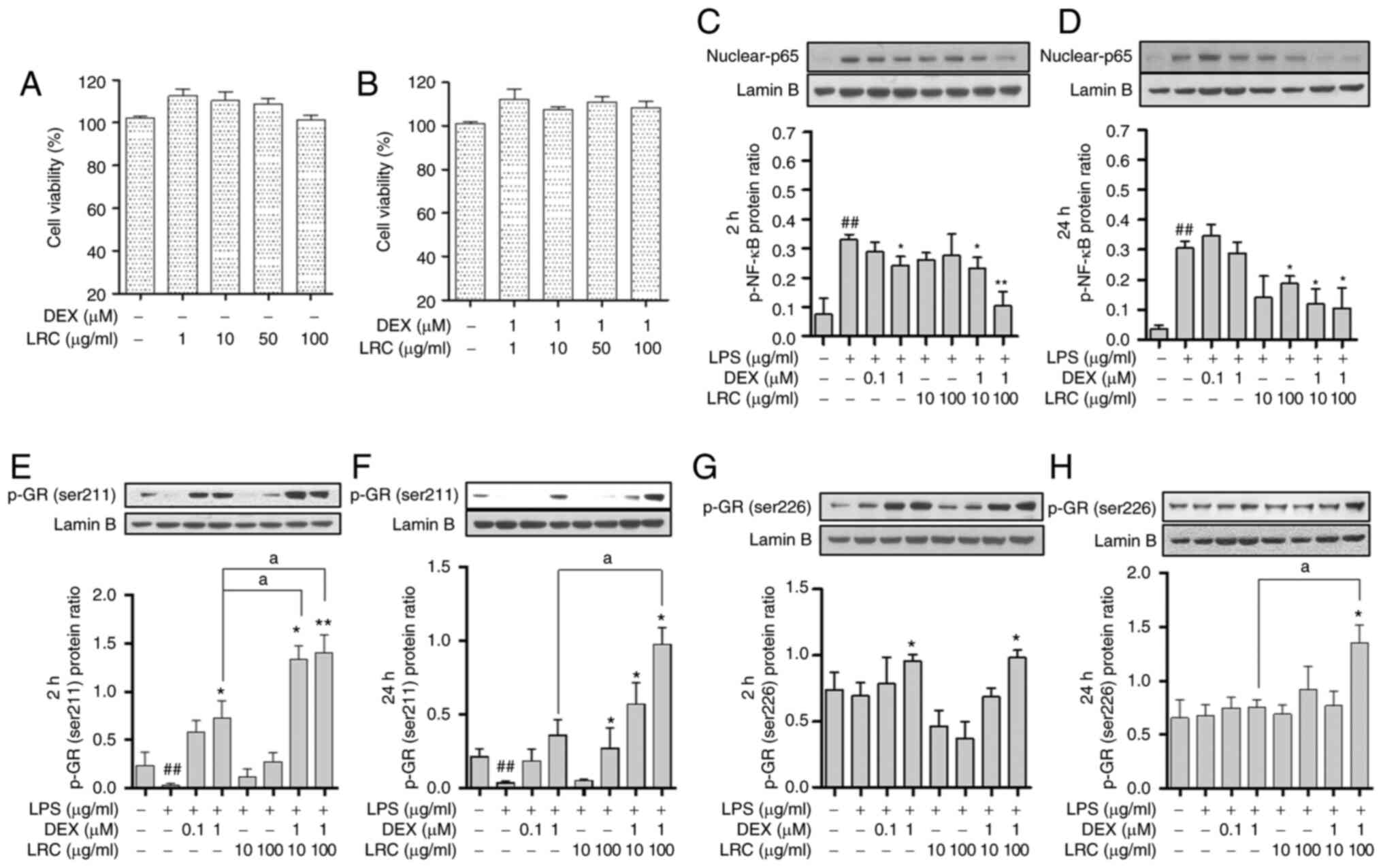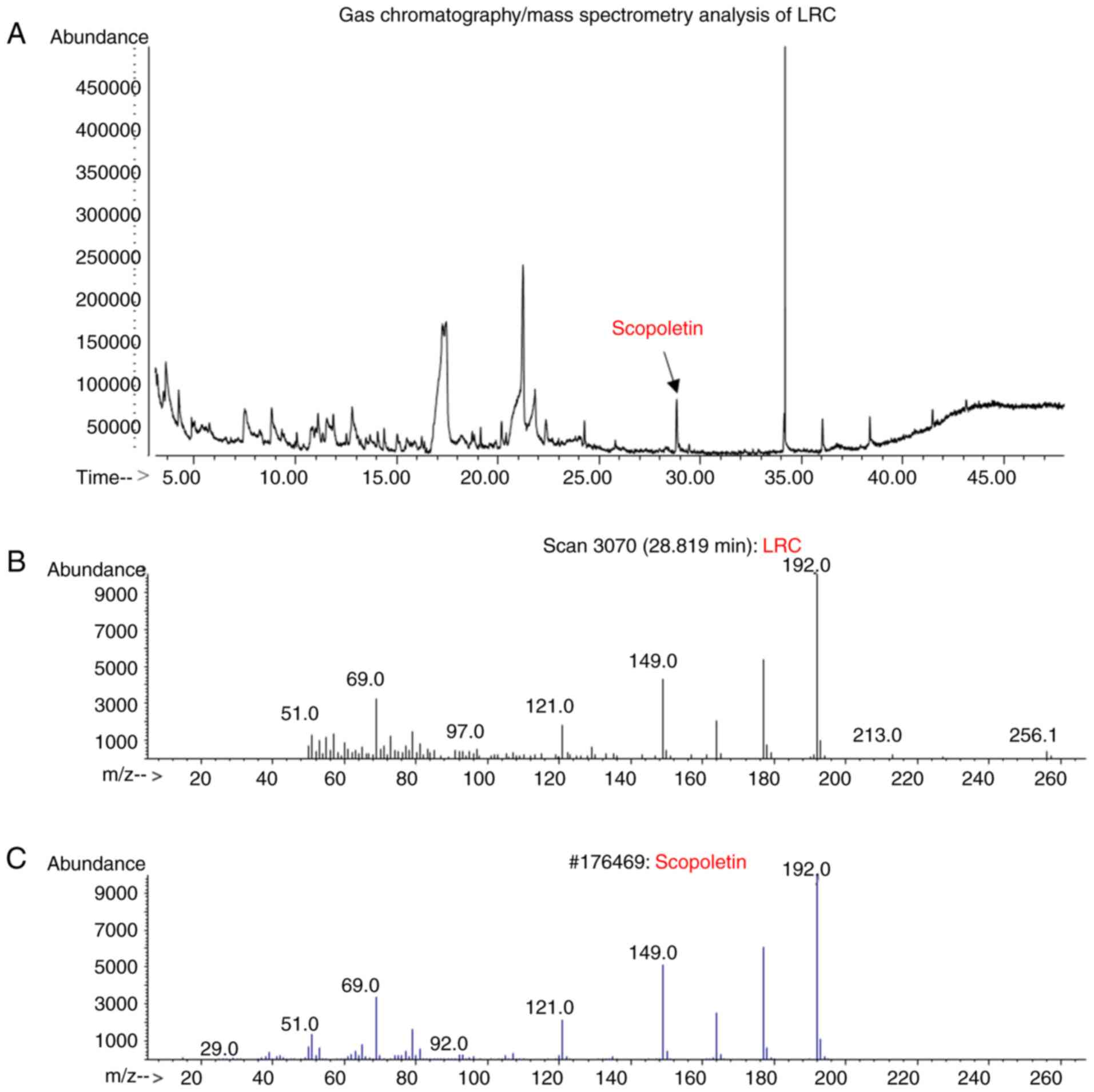|
1
|
Frenkel B, White W and Tuckermann J:
Glucocorticoid-induced osteoporosis. Adv Exp Med Biol. 872:179–215.
2015. View Article : Google Scholar : PubMed/NCBI
|
|
2
|
Henneicke H, Gasparini SJ,
Brennan-Speranza TC, Zhou H and Seibel MJ: Glucocorticoids and
bone: Local effects and systemic implications. Trends Endocrinol
Metab. 25:197–211. 2014. View Article : Google Scholar : PubMed/NCBI
|
|
3
|
Mirza F and Canalis E: Management of
endocrine disease: Secondary osteoporosis: pathophysiology and
management. Eur J Endocrinol. 173:R131–151. 2015. View Article : Google Scholar : PubMed/NCBI
|
|
4
|
Tuck S and Francis R: Testosterone, bone
and osteoporosis. Front Horm Res. 37:123–132. 2009. View Article : Google Scholar
|
|
5
|
Briot K and Roux C: Glucocorticoid-induced
osteoporosis. RMD Open. 1:e0000142015. View Article : Google Scholar : PubMed/NCBI
|
|
6
|
Shen C, Chen F, Zhang Y, Guo Y and Ding M:
Association between use of antiepileptic drugs and fracture risk: A
systematic review and meta-analysis. Bone. 64:246–253. 2014.
View Article : Google Scholar : PubMed/NCBI
|
|
7
|
Moura C, Bernatsky S, Abrahamowicz M,
Papaioannou A, Bessette L, Adachi J, Goltzman D, Prior J, Kreiger
N, Towheed T, et al: Antidepressant use and 10-year incident
fracture risk: The population-based Canadian Multicentre
Osteoporosis Study (CaMoS). Osteoporos Int. 25:1473–1481. 2014.
View Article : Google Scholar : PubMed/NCBI
|
|
8
|
Van Staa TP, Leufkens HG, Abenhaim L,
Zhang B and Cooper C: Use of oral corticosteroids and risk of
fractures. J Bone Miner Res. 15:993–1000. 2000. View Article : Google Scholar : PubMed/NCBI
|
|
9
|
Barnes PJ and Adcock IM: Glucocorticoid
resistance in inflammatory diseases. Lancet. 373:1905–1917. 2009.
View Article : Google Scholar : PubMed/NCBI
|
|
10
|
Schaaf MJ and Cidlowski JA: Molecular
mechanisms of glucocorticoid action and resistance. J Steroid
Biochem Mol Biol. 83:37–48. 2002. View Article : Google Scholar
|
|
11
|
Xie LW, Atanasov AG, Guo DA, Malainer C,
Zhang JX, Zehl M, Guan SH, Heiss EH, Urban E, Dirsch VM and Kopp B:
Activity-guided isolation of NF-κB inhibitors and PPARγ agonists
from the root bark of Lycium chinense Miller. J Ethnopharmacol.
152:470–477. 2014. View Article : Google Scholar : PubMed/NCBI
|
|
12
|
Gao D, Li Q, Liu Z, Li Y, Liu Z, Fan Y, Li
K, Han Z and Li J: Hypoglycemic effects and mechanisms of action of
Cortex Lycii Radicis on alloxan-induced diabetic mice. Yakugaku
Zasshi. 127:1715–1721. 2007. View Article : Google Scholar : PubMed/NCBI
|
|
13
|
Kim JH, Kim EY, Lee B, Min JH, Song DU,
Lim JM, Eom JW, Yeom M, Jung HS and Sohn Y: The effects of Lycii
Radicis Cortex on RANKL-induced osteoclast differentiation and
activation in RAW 264.7 cells. Int J Mol Med. 37:649–658. 2016.
View Article : Google Scholar : PubMed/NCBI
|
|
14
|
Park E, Jin HS, Cho DY, Kim J, Kim MC,
Choi CW, Jin Y, Lee JW, Park JH, Chung YS, et al: The effect of
Lycii Radicis Cortex extract on bone formation in vitro and in
vivo. Molecules. 19:19594–19609. 2014. View Article : Google Scholar : PubMed/NCBI
|
|
15
|
Park E, Kim J, Kim MC, Yeo S, Kim J, Park
S, Jo M, Choi CW, Jin HS, Lee SW, et al: Anti-osteoporotic effects
of kukoamine B Isolated from Lycii radicis cortex extract on
osteoblast and osteoclast cells and ovariectomized osteoporosis
model mice. Int J Mol Sci. 20:27842019. View Article : Google Scholar :
|
|
16
|
Kim J, Lee H, Kang KS, Chun KH and Hwang
GS: Protective effect of Korean Red Ginseng against
glucocorticoid-induced osteoporosis in vitro and in vivo. J Ginseng
Res. 39:46–53. 2015. View Article : Google Scholar
|
|
17
|
Ma Y, Yang H and Huang J: Icariin
ameliorates dexamethasone-induced bone deterioration in an
experimental mouse model via activation of microRNA186 inhibition
of cathepsin K. Mol Med Rep. 17:1633–1641. 2018.
|
|
18
|
Kim EY, Kim JH, Kim M, Park JH, Sohn Y and
Jung HS: Abeliophyllum distichum Nakai alleviates postmenopausal
osteoporosis in ovariectomized rats and prevents RANKL-induced
osteoclastogenesis in vitro. J Ethnopharmacol. 257:1128282020.
View Article : Google Scholar : PubMed/NCBI
|
|
19
|
Kim M, Kim HS, Kim JH, Kim EY, Lee B, Lee
SY, Jun JY, Kim MB, Sohn Y and Jung HS: Chaenomelis fructus
inhibits osteoclast differentiation by suppressing NFATc1
expression and prevents ovariectomy-induced osteoporosis. BMC
Complement Med Ther. 20:352020. View Article : Google Scholar : PubMed/NCBI
|
|
20
|
Kim JH, Kim M, Jung HS and Sohn Y:
Leonurus sibiricus L. ethanol extract promotes osteoblast
differentiation and inhibits osteoclast formation. Int J Mol Med.
44:913–926. 2019.PubMed/NCBI
|
|
21
|
Konappa N, Udayashankar AC, Krishnamurthy
S, Pradeep CK, Chowdappa S and Jogaiah S: GC-MS analysis of
phytoconstituents from Amomum nilgiricum and molecular docking
interactions of bioactive serverogenin acetate with target
proteins. Sci Rep. 10:164382020. View Article : Google Scholar : PubMed/NCBI
|
|
22
|
Zhang EY, Chen AY and Zhu BT: Mechanism of
dinitrochlorobenzene-induced dermatitis in mice: Role of specific
antibodies in pathogenesis. PLoS One. 4:e77032009. View Article : Google Scholar : PubMed/NCBI
|
|
23
|
Park G, Kim HG, Lim S, Lee W, Sim Y and Oh
MS: Coriander alleviates 2,4-dinitrochlorobenzene-induced contact
dermatitis-like skin lesions in mice. J Med Food. 17:862–868. 2014.
View Article : Google Scholar : PubMed/NCBI
|
|
24
|
Hiura K, Sumitani K, Kawata T, Higashino
K, Okawa M, Sato T, Hakeda Y and Kumegawa M: Mouse osteoblastic
cells (MC3T3-E1) at different stages of differentiation have
opposite effects on osteoclastic cell formation. Endocrinology.
128:1630–1637. 1991. View Article : Google Scholar : PubMed/NCBI
|
|
25
|
Elhelu MA: The role of macrophages in
immunology. J Natl Med Assoc. 75:314–317. 1983.PubMed/NCBI
|
|
26
|
van Rossum EF and Lamberts SW:
Glucocorticoid resistance syndrome: A diagnostic and therapeutic
approach. Best Pract Res Clin Endocrinol Metab. 20:611–626. 2006.
View Article : Google Scholar : PubMed/NCBI
|
|
27
|
Potterat O: Goji (Lycium barbarum and L.
Chinense): Phytochemistry, pharmacology and safety in the
perspective of traditional uses and recent popularity. Planta Med.
76:7–19. 2010. View Article : Google Scholar
|
|
28
|
Moghadam-Kia S and Werth VP: Prevention
and treatment of systemic glucocorticoid side effects. Int J
Dermatol. 49:239–248. 2010. View Article : Google Scholar : PubMed/NCBI
|
|
29
|
Lagos BR and Maibach HI: Frequency of
application of topical corticosteroids: An overview. Br J Dermatol.
139:763–766. 1998. View Article : Google Scholar
|
|
30
|
Haeck I, van Velsen S, de Bruin-Weller M
and Bruijnzeel-Koomen C: Bone mineral density in patients with
atopic dermatitis. Chem Immunol Allergy. 96:96–99. 2012. View Article : Google Scholar : PubMed/NCBI
|
|
31
|
Garg NK and Silverberg JI: Eczema is
associated with osteoporosis and fractures in adults: A US
population-based study. J Allergy Clin Immunol. 135:1085–1087 e2.
2015. View Article : Google Scholar
|
|
32
|
Zhang J, Song J and Shao J: Icariin
attenuates glucocorticoid-induced bone deteriorations, hypocalcemia
and hypercalciuria in mice. Int J Clin Exp Med. 8:7306–7314.
2015.PubMed/NCBI
|
|
33
|
Fan S, Gao X, Chen P and Li X: Myricetin
ameliorates glucocorticoid-induced osteoporosis through the ERK
signaling pathway. Life Sci. 207:205–211. 2018. View Article : Google Scholar : PubMed/NCBI
|
|
34
|
Shalhoub V, Conlon D, Tassinari M, Quinn
C, Partridge N, Stein GS and Lian JB: Glucocorticoids promote
development of the osteoblast phenotype by selectively modulating
expression of cell growth and differentiation associated genes. J
Cell Biochem. 50:425–440. 1992. View Article : Google Scholar : PubMed/NCBI
|
|
35
|
Igarashi M, Kamiya N, Hasegawa M, Kasuya
T, Takahashi T and Takagi M: Inductive effects of dexamethasone on
the gene expression of Cbfa1, Osterix and bone matrix proteins
during differentiation of cultured primary rat osteoblasts. J Mol
Histol. 35:3–10. 2004. View Article : Google Scholar : PubMed/NCBI
|
|
36
|
Parkinson IH and Fazzalari NL:
Interrelationships between structural parameters of cancellous bone
reveal accelerated structural change at low bone volume. J Bone
Miner Res. 18:2200–2205. 2003. View Article : Google Scholar : PubMed/NCBI
|
|
37
|
Kutuzova GD, Akhter S, Christakos S,
Vanhooke J, Kimmel-Jehan C and Deluca HF: Calbindin D(9k) knockout
mice are indistinguishable from wild-type mice in phenotype and
serum calcium level. Proc Natl Acad Sci USA. 103:12377–12381. 2006.
View Article : Google Scholar : PubMed/NCBI
|
|
38
|
Christakos S, Gabrielides C and Rhoten WB:
Vitamin D-dependent calcium binding proteins: Chemistry,
distribution, functional considerations, and molecular biology.
Endocr Rev. 10:3–26. 1989. View Article : Google Scholar : PubMed/NCBI
|
|
39
|
Bellido T, Huening M, Raval-Pandya M,
Manolagas SC and Christakos S: Calbindin-D28k is expressed in
osteoblastic cells and suppresses their apoptosis by inhibiting
caspase-3 activity. J Biol Chem. 275:26328–26332. 2000. View Article : Google Scholar : PubMed/NCBI
|
|
40
|
Kim MH, Lee GS, Jung EM, Choi KC, Oh GT
and Jeung EB: Dexamethasone differentially regulates renal and
duodenal calcium-processing genes in calbindin-D9k and -D28k
knockout mice. Exp Physiol. 94:138–151. 2009. View Article : Google Scholar
|
|
41
|
Church MK and Levi-Schaffer F: The human
mast cell. J Allergy Clin Immunol. 99:155–160. 1997. View Article : Google Scholar : PubMed/NCBI
|
|
42
|
Schoepe S, Schacke H, May E and Asadullah
K: Glucocorticoid therapy-induced skin atrophy. Exp Dermatol.
15:406–420. 2006. View Article : Google Scholar : PubMed/NCBI
|
|
43
|
Ji YZ, Geng L, Zhou HB, Wei HC and Chen
HD: Chinese herbal medicine Yougui Pill reduces exogenous
glucocorticoid-induced apoptosis in anterior pituitary cells.
Neural Regen Res. 11:1962–1968. 2016. View Article : Google Scholar
|
|
44
|
Chua CC, Chua BH, Chen Z, Landy C and
Hamdy RC: Dexamethasone induces caspase activation in murine
osteoblastic MC3T3-E1 cells. Biochim Biophys Acta. 1642:79–85.
2003. View Article : Google Scholar : PubMed/NCBI
|
|
45
|
Li P, Nijhawan D, Budihardjo I,
Srinivasula SM, Ahmad M, Alnemri ES and Wang X: Cytochrome c and
dATP-dependent formation of Apaf-1/caspase-9 complex initiates an
apoptotic protease cascade. Cell. 91:479–489. 1997. View Article : Google Scholar : PubMed/NCBI
|
|
46
|
Fischer U and Schulze-Osthoff K: New
approaches and therapeutics targeting apoptosis in disease.
Pharmacol Rev. 57:187–215. 2005. View Article : Google Scholar : PubMed/NCBI
|
|
47
|
Trapp T, Korhonen L, Besselmann M,
Martinez R, Mercer EA and Lindholm D: Transgenic mice
overexpressing XIAP in neurons show better outcome after transient
cerebral ischemia. Mol Cell Neurosci. 23:302–313. 2003. View Article : Google Scholar : PubMed/NCBI
|
|
48
|
Riggs BL and Melton LJ III: The prevention
and treatment of osteoporosis. N Engl J Med. 327:620–627. 1992.
View Article : Google Scholar : PubMed/NCBI
|
|
49
|
Owen TA, Aronow M, Shalhoub V, Barone LM,
Wilming L, Tassinari MS, Kennedy MB, Pockwinse S, Lian JB and Stein
GS: Progressive development of the rat osteoblast phenotype in
vitro: Reciprocal relationships in expression of genes associated
with osteoblast proliferation and differentiation during formation
of the bone extracellular matrix. J Cell Physiol. 143:420–430.
1990. View Article : Google Scholar : PubMed/NCBI
|
|
50
|
Huang W, Rudkin GH, Carlsen B, Ishida K,
Ghasri P, Anvar B, Yamaguchi DT and Miller TA: Overexpression of
BMP-2 modulates morphology, growth, and gene expression in
osteoblastic cells. Exp Cell Res. 274:226–234. 2002. View Article : Google Scholar : PubMed/NCBI
|
|
51
|
Lee KS, Kim HJ, Li QL, Chi XZ, Ueta C,
Komori T, Wozney JM, Kim EG, Choi JY, Ryoo HM and Bae SC: Runx2 is
a common target of transforming growth factor beta1 and bone
morphogenetic protein 2, and cooperation between Runx2 and Smad5
induces osteoblast-specific gene expression in the pluripotent
mesenchymal precursor cell line C2C12. Mol Cell Biol. 20:8783–8792.
2000. View Article : Google Scholar : PubMed/NCBI
|
|
52
|
Gu H, Boonanantanasarn K, Kang M, Kim I,
Woo KM, Ryoo HM and Baek JH: Morinda citrifolia leaf extract
enhances osteogenic differentiation through activation of
Wnt/beta-catenin signaling. J Med Food. 21:57–69. 2018. View Article : Google Scholar
|
|
53
|
Schaaf MJ and Cidlowski JA: Molecular
determinants of glucocorticoid receptor mobility in living cells:
The importance of ligand affinity. Mol Cell Biol. 23:1922–1934.
2003. View Article : Google Scholar : PubMed/NCBI
|
|
54
|
Maltese P, Canestrari E, Palma L, Ruzzo A,
Corini F, Menotta M, Andreoni F, Latiano A, Annese V and Magnani M:
High resolution melting (HRM) analysis for the detection of
ER22/23EK, BclI, and N363S polymorphisms of the glucocorticoid
receptor gene. J Steroid Biochem Mol Biol. 113:269–274. 2009.
View Article : Google Scholar : PubMed/NCBI
|
|
55
|
De Bosscher K, Vanden Berghe W and
Haegeman G: The interplay between the glucocorticoid receptor and
nuclear factor-kappaB or activator protein-1: Molecular mechanisms
for gene repression. Endocr Rev. 24:488–522. 2003. View Article : Google Scholar : PubMed/NCBI
|
|
56
|
Dostert A and Heinzel T: Negative
glucocorticoid receptor response elements and their role in
glucocorticoid action. Curr Pharm Des. 10:2807–2816. 2004.
View Article : Google Scholar : PubMed/NCBI
|
|
57
|
Charmandari E, Kino T, Ichijo T and
Chrousos GP: Generalized glucocorticoid resistance: Clinical
aspects, molecular mechanisms, and implications of a rare genetic
disorder. J Clin Endocrinol Metab. 93:1563–1572. 2008. View Article : Google Scholar : PubMed/NCBI
|
|
58
|
Blind RD and Garabedian MJ: Differential
recruitment of glucocorticoid receptor phospho-isoforms to
glucocorticoid-induced genes. J Steroid Biochem Mol Biol.
109:150–157. 2008. View Article : Google Scholar : PubMed/NCBI
|
|
59
|
Wang Z, Chen W, Kono E, Dang T and
Garabedian MJ: Modulation of glucocorticoid receptor
phosphorylation and transcriptional activity by a
C-terminal-associated protein phosphatase. Mol Endocrinol.
21:625–634. 2007. View Article : Google Scholar
|
|
60
|
Woodbury R and Kligman AM: The hairless
mouse model for assaying the atrophogenicity of topical
corticosteroids. Acta Derm Venereol. 72:403–406. 1992.PubMed/NCBI
|





